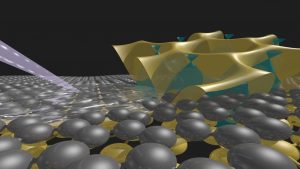Gold is a scarse element on the earth’s crust and is difficult to extract. It is also resistant to corrosion and it does not oxidize, so it can preserve its properties with time. It is also heavy, malleable and easy to mould. It therefore became the reference material in the human history for luxury and wealth. Nowadays gold finds its use in technological applications because it is simply the best chemically stable electrical conductor.
However, under some conditions, low-dimensional gold can become an insulator, i.e. a material that is not able to transport electrical current from one side to the other of a lead. In a recent work published on Nature Communications (Forti et al., Nature Communications 11, 2236 2020), researchers from CNI@NEST (Pisa) and Max Planck Institute (Stuttgart) show that by encapsulating a single layer of gold in between silicon carbide and graphene, gold does not behave as a metal anymore, but it becomes insulating. The original metallic character of gold is recovered when one sandwiches two layers instead of just one. This is the first report on the existence of two-dimensional gold and on its enticing electronic properties.

